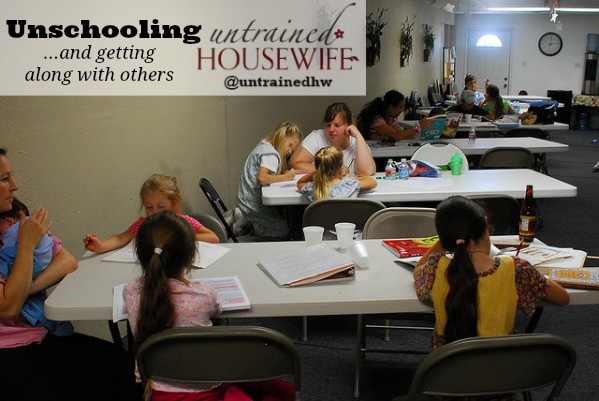It is obvious that our children need to learn how to get along with others in order to be well prepared for adult life. However, the suggestion that a child must attend a public school to learn that is simply bogus. They will become adults, regardless of their educational environment. The question each parent must ask is, “What can I do to best prepare my child for adult life?” This begs the question, what exactly DO students need to know in their adult life, and what is the best environment in which to learn it? One thing they need to learn is how to get along with others of all ages.
In the adult world, those “others” include everybody – not just those who are the same age. In a public school, children are segregated by age to study, and then quickly subscribe to the notion that it is not acceptable to socialize with those not in their own grade. It is unthinkable for a fifth grader to play with a fourth grader at recess! And certainly Ms. Smith’s class cannot sit at the same lunch table as Ms. Jones’ class! Oh, the horror!
In the more integrated context of homeschooling or unschooling, what are some ideas for consciously teaching your children how to get along with others?
Join a Community Theater
In an unschooling situation, the students each lead the entire family – including all ages of siblings – to participate in community activities that include people of all ages. The family might participate together in a community theater, in which children and adults of all ages mingle together to produce a quality performance. The children learn to respect not only their elders, but all of those around them, and to also respect all of the many gifts that individuals bring to a project such as this. While they may be able to partake of the Arts in a public school, those performances are generally limited to one age group, like high school, and the only adults involved are the faculty.
Dine Out
While public school children are limited to eating lunch with their same-age peers, the unschooled child may eat in all kinds of restaurants, surrounded by all ages, all the while learning the social graces appropriate to their dining environment. Make an effort to go out to eat in a variety of settings. Budget for higher-end restaurants now and then, where the children are exposed to appropriate etiquette and behavior. Show them ahead of time what to expect through a role play and perhaps a read aloud story. You will raise eyebrows when you go into a fancy restaurant in the middle of the day — why are your children not in school? But you just smile and remind yourself that this IS the school! For today, anyway.
Go to fast food restaurants, buffets, and pot-lucks. Teach children to clean up after themselves, and perhaps find someone around them that they can help. Teach them not to contaminate food at buffets. Teach them to only take what they will eat, and to eat what they take at pot-lucks.
While the public schooled child is being taught to eat in a cafeteria, segregated by age, the unschooled child is taught how to be comfortable in all settings, mingling with all people.
Join a Homeschool Group or Team
There are homeschoolers all over the place. Many of the groups also sponsor teams. The difference between public school groups (classes) and homeschooling groups and teams is, again, segregation. Think back to your own school days. The classes were divided by age, and the teams were generally divided by class. Usually, freshman played with freshman, and seniors with seniors.
In a homeschool group or cooperative learning situation, there are several class choices for your child (student led learning). But within that class, the students will be of a varied age. So again, your child will be associating with – learning how to get along with – a variety of people, not just those of his same age.
On the homeschool teams, the players will most likely be selected based on talent, ability and experience, and less so by what ‘class’ they are in. My boys were 12 year-olds playing with seniors, and then seniors playing with 12 year olds! The cheerleaders ranged in age from 6 to 16. How fun is that, for all of the students!
Teach the Whole Family
Allow the children to select a project together, but also allow them to select projects as individuals! Help them select unit studies that can be taught to all the children at once. Have a theme of the month. Let the olders teach the youngers. Let them interact on projects. But never, ever, separate t hem by age!
Some unit study resources are Konos and Horizon. However, a purchased set is not required. Follow the lead of your students. If somebody finds a cool bug, gather the children around. Look it up on the internet and at the library. Get books to learn more about it. Try to create a habitat so you can keep it for a while. Draw pictures of it. Learn what it eats and see if you can create a habitat for that. Discover what eats the bug and how it all fits in the food chain.
Education NEVER ends when you approach it this way. You never arrive at the end of the textbook, and you are never too old or young to learn. This constant interaction, learning from and respecting everyone around you, is the best kind of preparation for children to prepare for future adult interactions.





